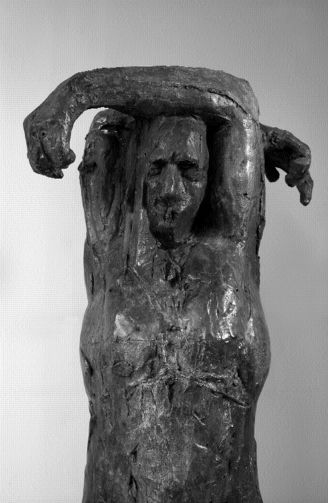
| The Frances Noble talks to Laurence Edwards about his talent for finding the form within the mould. |
|
A crow flies into the circular picture (upside down) and settles (upside down) in the branches of an upside down tree. Plumes of pampas grass wave weirdly in the upside down breeze. This is the image projected by the camera obscura onto the wall in the downstairs cloakroom at Laurence Edward’s Suffolk home – gentle, and almost lyrical. It is an image that would seem more appealing to a landscape painter than to a bronze sculptor whose working practice is, at times, brutal, strenuous and noisy.
Which artists did you particularly admire then? | |
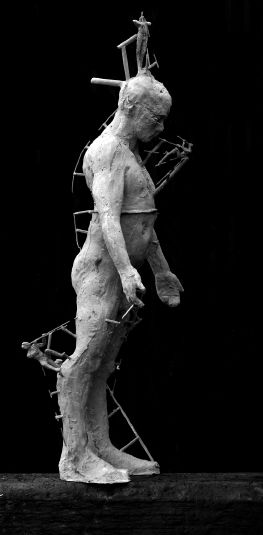 |
Do you work to commission or to satisfy your own artistic development? I most enjoy working in collaboration and that’s how I see working to commission, as a partnership between the client and the artist to reach a mutually satisfactory piece of work. I actually enjoy the negotiation which takes place for a commission. I used to be a lone-ranger doing lots of portraiture and casting for other people. Many sculptors create the piece but leave the mould making and the actual metal pouring to someone else. You could argue that the really creative part of bronze sculpting is in making the clay original, but I see the process right through; making my pieces is a continuous process from the concept to the finished object. For a young sculptor, casting for other people enables them to gain experience and make a living! Pouring like that is all very well and pays the bills but now I need to do my own stuff and I’ve cut down the amount of work I do for other people. I don’t think I’m there yet – I’m in for the long haul, I’ve never been part of the firework display of some artists and I certainly don’t want to be burnt out by the time I’m 50. This project, these spaces, creating the workshops and studios here is part of that collaborative process that feeds my own work. I used to teach a bit but I don’t enjoy it so much these days. When students come in one day a week it’s hard to keep your interest going. I’m much happier sharing my knowledge and skill in joint enterprises like the iron-pours. |
|
What is an iron pour? I am the co-founder of the US-UK Iron Pour residency and exchange programme. A group of people from college moved to America and re-discovered the almost domestic scale of iron pouring, the sort of process that the industrial revolution brought to small workshops in this country in the eighteenth and nineteenth centuries. Bringing this modern version of that process back to this country has been great. We built our first cupola in 1997 with the help of the Americans, now we exchange residencies between here and our sister studio in New Orleans. We advertise internationally for artists to join us, and we camp for two weeks, build the moulds together and end with the massive climax of the pour itself. It’s hard, hot work that turns into an all day party with loads of drink to quench the tremendous thirst that comes from the heat of the fire. Because of the work involved in reaching and maintaining the necessary heat and the sheer scale of the thing it’s a real team experience and I love every minute. The advantage of iron pouring for the sculptor is that the cost of iron is lower than bronze. Iron comes from scrap metal; that means you can try out ideas more easily. |
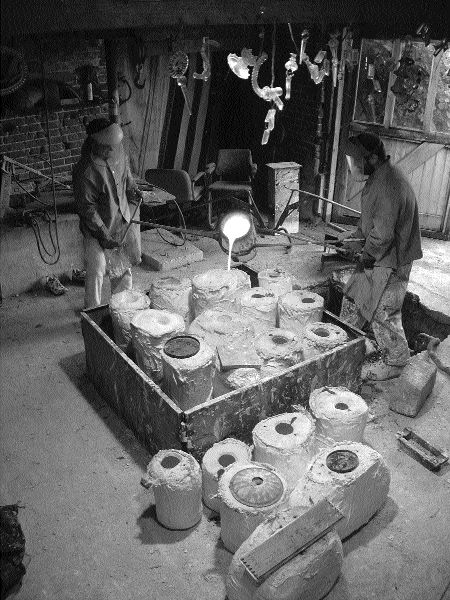 |
|
What’s a cupola? It’s actually a vertical furnace in which iron can be heated until it melts and then tapped off. It’s a major undertaking keeping it up to temperature and fed with enough material, hard, hot and heavy work. But if a group of artists work together and all have their moulds ready for casting it can be a good experience. A long day, though, and we usually get through quite a lot of drink – it’s a working party really. It sounds as if working with other people is very important to you. Yes it is. Even when I spend time alone I still need to celebrate with other people, that’s why we have kept the tradition of the Donatello Dinner going. Tissa started it at the RCA. Donatello was his favourite sculptor and he celebrated Donatello’s birthday every year by cooking dinner for his friends and colleagues in the foundry. It was carried up to the Senior Common Room. Here in Suffolk we continue that tradition and on 13th December every year, we collect together about 60 friends and roast a Jacob sheep and drink a lot of wine! The party can go on all night. Bronze sculptures are really expensive aren’t they? There’s an established market, especially in the commercial sector and the price of casting, say a portrait head, might be about £600. It’s not the cost of the material itself which makes the work expensive (I use industry-standard silicon bronze), it’s all the paraphernalia around building the models, the moulds and doing the castings – it’s the time factor really. The price of a finished piece, bought from a show, would be divided roughly a third to the sculptor, a third to the caster and a third to the gallery. Bronze seems to hold its value compared to other metals – and it’s certainly easier to sell. | |
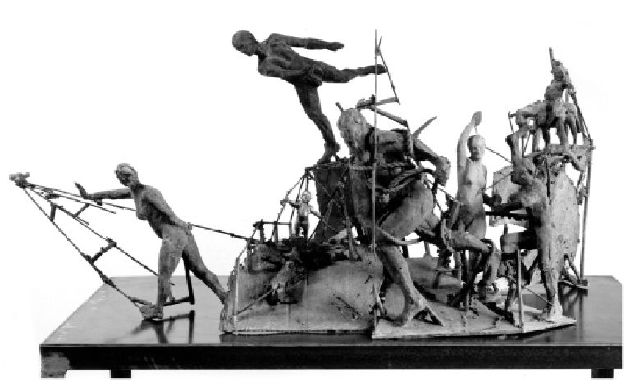 | |
|
Can you describe some of your recent work? I did a piece of collaborative sculpture with Les Bicknell in Louth in Lincolnshire recently. The site-specific work was made to celebrate the Meridian Line which passes through Louth. We made a group of three figures which appear around the town and seem to investigate the line which emerges from, and then disappears back into the ground where each figure stands. The first figure is outside the church, it holds one end of the line and seems to be reading the words which are engraved on it. The second figure standing outside the library, contemplates the line in a less puzzled way. The third figure, outside the school, is held within a circle formed by the line, a symbol of the completeness of the piece. Back in his bright, comfortable kitchen with his wife and children around him, Laurence relaxes and the fiery energy of his professional self settles. The line which links the man and his work to this home and to his studio is looped round him; that’s what keeps the romance of making alive for him. A romance which will continue as his work and his children grow. His wife Jo is an artist too, but at the moment with two young children her own work is on hold. She is content to see her children develop. For the time being that is enough. And Laurence, how does he feel about fatherhood? Does he want his boys to follow him and become artists and makers? ‘I have very ambivalent feelings about what I would like to see the boys do,’ he says, ‘I tell myself I don’t want them to follow me; but I think I’m partly kidding myself. The other day I asked my eldest boy if he wanted to be a policeman, he said “No, I want to work with you,” and I was unreasonably pleased about that. They will follow their own lines.’ | |
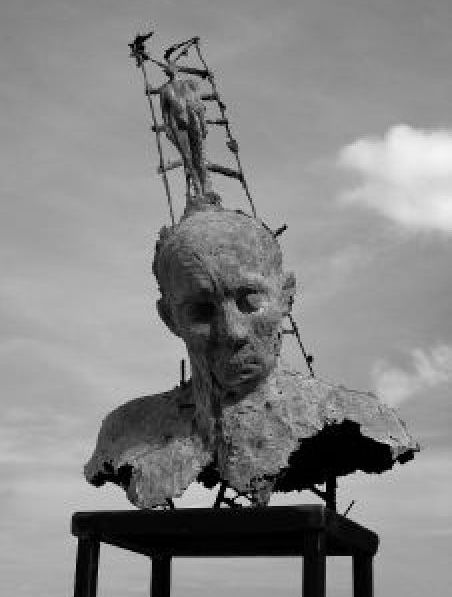
| |
| Home Page | See some of Laurence Edward's current work |
